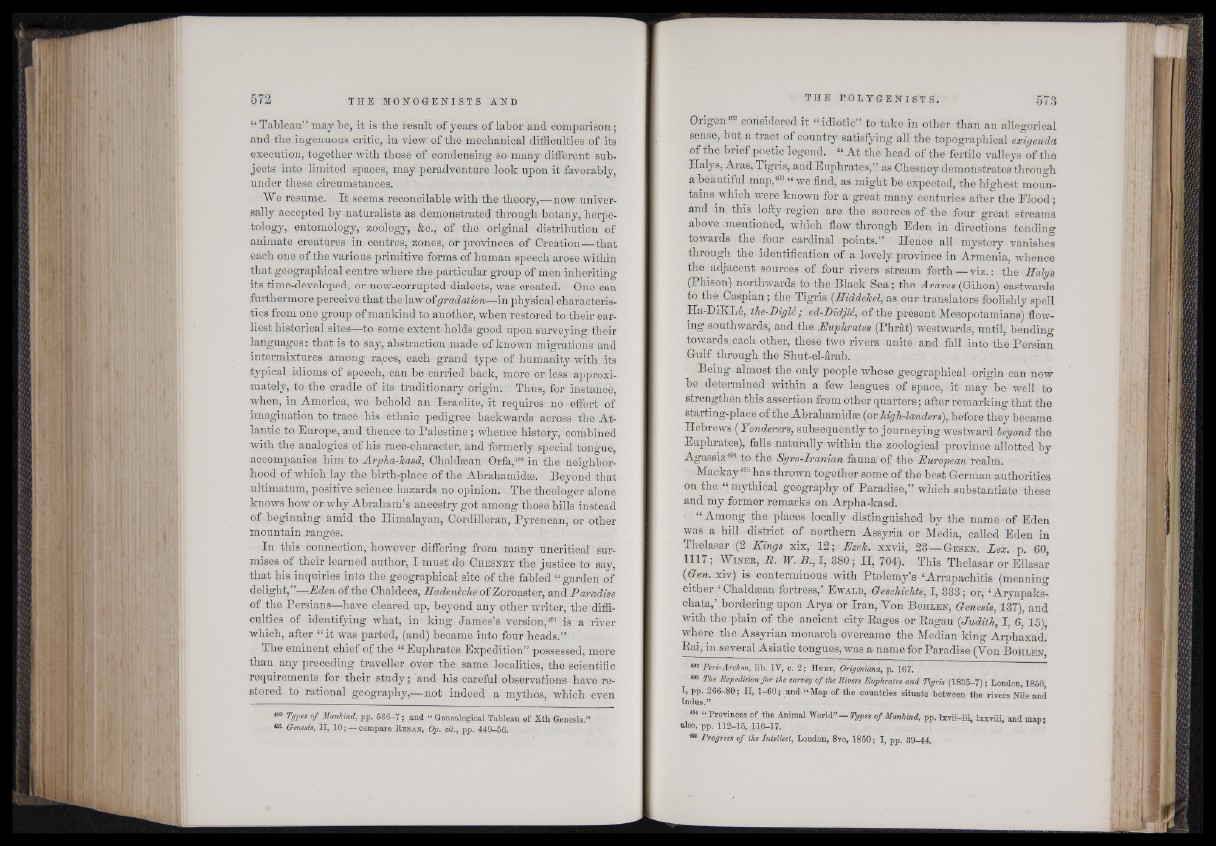
“ Tableau” may be, it is the result of years of labor and comparison;
and the ingenuous critic, in view of the mechanical difficulties of its
execution, together with those of condensing so many different subjects
into limited spaces, may peradventure look upon it favorably,
under these circumstances.
We resume. It seems reconcilable with the theory,— now universally
accepted by naturalists as demonstrated through botany, herpetology,
entomology, zoology, &c., of the original distribution of
animate creatures in centres, zones, or provinces of Creation -»¿that
each one of the various primitive forms of human speech arose within
that geographical centre where the particular group of men inheriting
its time-developed, or now-corrupted dialects, was created. One can
furthermore perceive that the law of gradation—in physical characteristics
from one group of mankind to another* when restored to their earliest
historical sites—to some extent holds good upon surveying their
languages: that is to say, abstraction made of known migrations and
intermixtures among ra,ces, each grand type of humanity with its
typical idioms of speech, can be carried back, more or less approximately,
to the cradle of its traditionary origin. Thus, for instance,
when, in America, we behold an Israelite, it requires no effort of
imagination to trace his ethnic pedigree backwards across the Atlantic
to Europe, and thence to Palestine; whence history, combined
with the analogies of his race-character, and formerly special tongue,
accompanies him to Arpha-kasd, Chaldsean Orfa,490 in the neighborhood
of which lay the birth-place of the Abrahamidte. Beyond that
ultimatum, positive science hazards no opinion. The theologer alone
knows how or why Abraham’s ancestry got among those hills instead
of beginning amid the Himalayan, Cordilleran, Pyrenean, or other
mountain ranges.
In this connection, however differing from many uncritical surmises
of their learned author, I must do CheSNey the justice to Say,
that his inquiries into the geographical site of the fabled I garden of
delight,”«-Eden of the Chaldees, Hadenkche of Zoroaster, and Parhdise
of the Persians—have cleared up, beyond any other writer, the difficulties
of identifying what, in king James's version,491 is a river
which, after “ it was parted, (and) became into four heads.”
The eminent chief of the “ Euphrates Expedition” possessed, more
than any preceding traveller over the same localities, the scientific
requirements for their study; and his careful observations have restored
to rational geography,— not indeed a mythos, which even
490 Types of Mankind, pp. 536-7; and “ Genealogical Tableau of Xth Genesis.”
491 Genesis, II, 10; — compare R en a n , Op. cit., pp. 449-56.
Origen492 considered it «idiotic” to take in other than an allegorical
sense, but a tract of country satisfying all the topographical exigenda
of the brief poetic legend. “ At the head of the fertile valleys of the
Halys, Aras, Tigris, and Euphrates,” as Chesney demonstrates through
a beautiful map,493 “ we find, as might be expected, the highest mountains
which were known for a great many centuries after the Flood;
and in this lofty region are the sources of the four great streams
above mentioned, which flow through Eden in directions tending
towards the four cardinal points.” Hence all mystery vanishes
through the identification of a lovely province in Armenia, whence
the adjacent sources of four rivers stream forth — viz.: the Halys
(Phison) northwards to the Black Sea; the Araxes (Gihon) eastwards
to the Caspian; the Tigris (Hiddekel, as our translators foolishly spell
Ha-DiKLe, the-BigU1 ed-BidjlA, of the present Mesopotamians) flow-
ing southwards, and the Euphrates (Phrat) westwards, until, bending
towards each other, these two rivers unite and fall into the Persian
Gulf through the Shut-el-arab.
Being almost the only people whose geographical origin can now
be determined within a few leagues of space, it may be well to
strengthen this assertion from other quarters; after remarking that the
starting-place of the Abrahamidse (or high-landers), before they became
Hebrews {Yonderers, subsequently to journeying westward heyond the
Euphrates), falls naturally within the zoological province allotted by
Agassiz404 to the Syro-Iranian fauna' of the European realm.
Mackay,495 has thrown together some of the best German authorities
on the “ mythical geography of Paradise,” which substantiate these
and my former remarks on Arpha-kasd.
“ Among the places locally distinguished by the name of Eden
was a hill district of northern Assyria or Media, called Eden in
Thelasar (2 Kings xix, 12; Ezek. xxvii, 23— G e se n . Lex. p. 60,
1117; Winer, R. W. B., I, 380; H, 704). This Thelasar or Ellasar
(Gen. xiv) is conterminous with Ptolemy’s ‘Arrapachitis (meaning
either ‘Chaldsean fortress,’ E wald, Geschichte, I, 333; or, ‘Aryapaks-
chata,’ bordering upon Arya or Iran, Yon B ohlen, Genesis, 137), and
with the plain of the ancient city Rages or Ragau (Judith, I, 6, 15),
where the Assyrian monarch overcame the Median king Arphaxad.
Rai, in several Asiatic tongues, was a name for Paradise (Yon B ohlen,
499 Peri-Archon, l i b . IV, c. 2; H o e t , Origmiana, p. 167.
493 The Expedition for the survey of the Rivers Euphrates and Tigris (1835-7); London, 1850
I, pp. 266-80; II, 1-60; and “Map of the countries situate between the rivers Nile and
tndij.s.”
494 “ Provinces of the Animal World”— Types of Mankind, pp. lxvii-iii, lxxviii, and map-
also, pp. 112-15, 116-17.
495 Progress of the Intellect, London, 8vo, 1850; I, pp. 39-44.